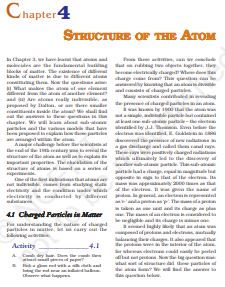‘NCERT Solutions for Class 9 Science Chapter 4‘ PDF Quick download link is given at the bottom of this article. You can see the PDF demo, size of the PDF, page numbers, and direct download Free PDF of ‘Ncert Class 9 Science Chapter 4 Exercise Solution’ using the download button.
NCERT Class 9 Science Textbook Chapter 4 With Answer PDF Free Download

Chapter 4: Structure of Atoms
4.2 The Structure of an Atom
We have learned Dalton’s atomic theory in Chapter 3, which suggested that the atom was indivisible and indestructible.
But the discovery of two fundamental particles (electrons and protons) inside the atom, led to the failure of this aspect of Dalton’s atomic theory.
It was then considered necessary to know how electrons and protons are arranged within an atom.
For explaining this, many scientists proposed various atomic models. J.J. Thomson was the first one to propose a model for the structure of an atom.
4.2.1 THOMSON’S MODEL OF AN ATOM
Thomson proposed the model of an atom be similar to that of a Christmas pudding. The electrons, in a sphere of positive charge, were like currants (dry fruits) in a spherical Christmas pudding.
We can also think of a watermelon, the positive charge in the atom is spread all over like the red edible part of the watermelon, while the electrons are studded in the positively charged sphere, like the seeds in the watermelon.
Thomson proposed that:
(i) An atom consists of a positively charged sphere and the electrons are embedded in it.
(ii) The negative and positive charges are equal in magnitude. So, the atom as a whole is electrically neutral.
Although Thomson’s model explained that atoms are electrically neutral, the results of experiments carried out by other scientists could not be explained by this model, as we will see below
4.2.2 Rutherford’s Model OF An Atom
Ernest Rutherford was interested in knowing how the electrons are arranged within an atom. Rutherford designed an experiment for this. In this experiment, fast-moving alpha (α)-particles were made to fall on a thin gold foil.
• He selected a gold foil because he wanted as thin a layer as possible. This gold foil was about 1000 atoms thick.
• α-particles are doubly-charged helium ions. Since they have a mass of 4 u, the fast-moving α-particles have a considerable amount of energy.
• It was expected that α-particles would be deflected by the sub-atomic particles in the gold atoms. Since the α-particles were much heavier than the protons, he did not expect to see large deflections.
4.2.3 BOHR’S MODEL OF ATOM
In order to overcome the objections raised against Rutherford’s model of the atom, Neils Bohr put forward the following postulates about the model of an atom:
(i) Only certain special orbits are known as discrete orbits of electrons are allowed inside the atom.
(ii) While revolving in discrete orbits the electrons do not radiate energy
NCERT Solutions Class 9 Science Chapter 4 Matter in Our Surroundings
1. On the basis of Thompson’s model of an atom, explain how the atom is neutral as a whole.
Solution:
As per Thompson’s model of an atom,
(i) An atom contains a positively charged sphere in which the negatively charged electrons are implanted.
(ii) Electrons and protons are equal in magnitude, hence an atom, on the whole, is electrically neutral.
2. On the basis of Rutherford’s model of an atom, which subatomic particle is present in the nucleus of an atom?
Solution:
As per Rutherford’s model of an atom, the positively charged protons are the ones that are present in the atom.
3. What are the limitations of Rutherford’s model of the atom?
Solution:
Following are the limitations of Rutherford’s model of the atom:
- There is no expected stability in the revolution of the electron in a circular orbit
- Charged particles radiate energy when accelerated thus causing the revolving electrons to lose energy and would fall into the nucleus
- Hence atoms must be highly unstable. The matter would not exist in its known form which clearly is an assumption as atoms are highly stable.
4. Describe Bohr’s model of the atom.
Solution:
- An atom holds the nucleus at the center.
- Negatively charged electrons revolve around the nucleus.
- The atoms in it contain distinct orbits of electrons.
- Electrons do not radiate energy when they are in their orbits.
- The distinct orbits are named K, L, M, and N orbits. Numbers used to denote them are n=1, 2, 3, 4
5. Define valency by taking examples of silicon and oxygen.
Solution:
The definite combining capacity of the atoms of each element, wherein electrons are lost, gained, or shared to make the octet of electrons present in the outermost shell is defined as valency. To measure valency, we can figure out the number of electrons that are required to complete the shell in which it is contained or lose excess electrons if present, once the filling is complete.
Example: To find the valency of silicon:
The atomic number of silicon is 14
The number of electrons is equal to the number of protons in silicon i.e., 14
The distribution of electrons in silicon atom is K – 2, L – 8, M – 4
Hence, from the distribution of silicon, it is clearly evident that to fill the M shell 4 electrons are required. Therefore its valency is 8-4=4.
To find the valency of oxygen:
The atomic number of oxygen is 8
The number of electrons is equal to the number of protons in oxygen i.e., 8
The distribution of electrons in oxygen atom is K – 2, L – 6
Hence, from the distribution of oxygen, it is clearly evident that to fill the M shell 6 more electrons are required. Therefore its valency is 8-6=2.
Structure of Atoms NCERT Textbook With Solutions PDF Free Download